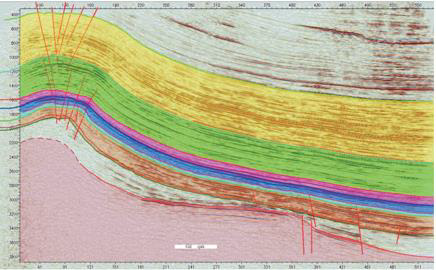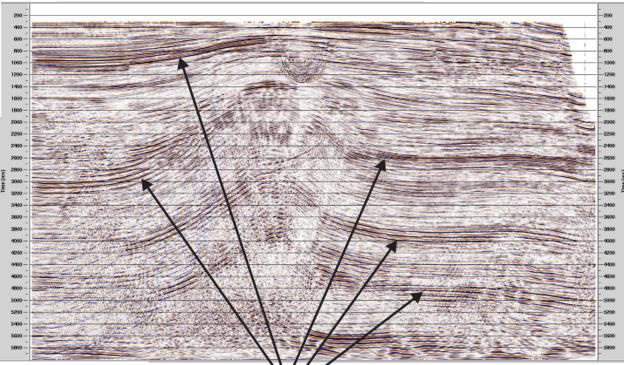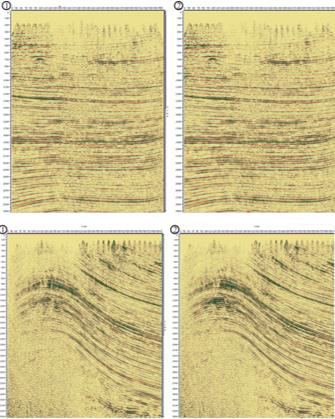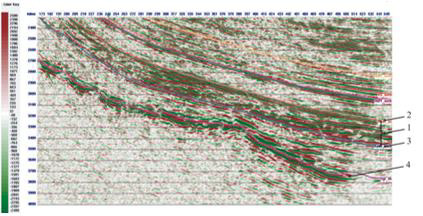Research Article 
 Creative Commons, CC-BY
Creative Commons, CC-BY
Isolation and tracking of some types of breaks in sedimentation by 3D seismic survey (on the example of individual areas of Azerbaijan)
*Corresponding author: Ahmadov Tofig Rashid, Department of Geophysics, University of Azerbaijan, Baku.
Received: January 21, 2022; Published: March 07, 2022
DOI: 10.34297/AJBSR.2022.15.002150
Abstract
The paper underlines that reserve in anticline traps are exhausting both in Azerbaijan and around the globe and in this respect the priority today is exploration for hydrocarbon resources in non-anticline traps, which are formed with a certain role of nondepositions or in other words - breaks in sedimentation process. In this respect, it is natural that in the recent years the geoscientists pay a close attention to research on non-anticline traps and non-depositions since they were not covered by specific studies until now. It should be noted that studies held at the “Geophysics” Department of Azerbaijan State Oil and Industry University are some kind of exception. In this paper, results of some studies are given, including outlined boundaries of unconformities, related to nondepositions under various seism geological conditions in onshore and offshore areas. It has been also indicated that no specific studies of non-depositions by use of seismic survey have been held in Azerbaijan. This paper is devoted to outlining and tracking of boundaries related to breaks in sedimentation process analyzed by use of various seismic survey data acquired in various oil and gas regions of Azerbaijan.
First, the paper considers the brief geological and geophysical characteristics of non-depositions, and it is noted that a special role in their study is attributed to high-resolution seismic survey and electric survey. It is specially underlined that under the nondepositions the geoscientists mean the absence of terrestrial depositions and outlining and tracing of regional and reference seismic horizons are not complicated task. According to the latest studies, during the periods of global and local breaks in sedimentation process, the depositions of terrestrial origin are absent, however deposition of cosmic dust is continuously going on and this has been proved by various studies. The paper also indicated the role of some researchers in studies of depositions of cosmic origin and their reflections in seismic data. The results of studies of depositions of cosmic origin by use of modeling held in Azerbaijan have been also displayed.
Keywords: Non-Depositions, High-Resolution Seismic Survey, Ranked Seismic Horizons, Unconformity Boundaries, Cosmic Dust.
Introduction
The sharp decline of the world’s oil and gas reserves related to anticline traps is a well-known issue, and in this sense, Azerbaijan is no exception. Due to this, the attention of geologists and geophysicists are currently focusing on non-anticline traps. It is known that non-deposition or hiatus processes play a very important role information of such traps. Significant progress has been made in studies of non-deposition periods by use of seismic survey. Some research in this area have been done at the Department of Geophysical Exploration Methods of Azerbaijan State Oil and Industry University. In this respect, the research of P.Z. Mammadov devoted to study of unconformity boundaries created by non-depositions under various seism geological conditions onshore and offshore Azerbaijan are noteworthy [1]. However, no thorough research has been conducted in Azerbaijan in order to study the boundaries of non-depositions by seismic survey.
First, let us consider briefly geological-geophysical nature of breaks in sedimentation process. It must be noted that high resolution seismic and electrical surveys have an important role in the study of non-depositions [2-4]. When talking about nondepositions or hiatus the geologists and geophysicists understand the absence of terrestrial sediments in the section [5,6]. Similar to sedimentary geological objects, non-depositions are ranked according to spatial and temporal characteristics [2,4,5]. The ranks of non-depositions are very well matched with the ranks of isolated geological sedimentary bodies. Regional and reference non-depositions are very clearly traced in seismic time sections and their study is not too complicated (Figure 1). Regional and reference non-depositions are existing for a long time and embrace a large part (about 90%) of sedimentary process [7,8]. Local nondepositions are relatively short, and their study by seismic survey has certain complications. Absolute spectral-time analysis (SVAN) must be used in the study of this type of non-depositions. It should be noted that from the point of view of seismic exploration, nondepositions cause mainly thick stratification of the section [9,10].
Problem Statement
This paper deals with identification and tracking of reflective boundaries (seismic horizons, conformity layers) associated with non-deposition intervals based on seismic survey data acquired in oil and gas regions of Azerbaijan.
Research Questions
According to previous assumptions, non-depositions generally mean the cease of the sedimentation process. According to modern studies while the global or local non-depositions, rocks of terrestrial origin do not really precipitate, however during this period, sediments (dusts) of cosmic origin settle continuously [11- ,13]. Estimates of the amount of matter of cosmic origin reaching the Earth’s surface vary. [12] approximately 10million tons of space dust per year falls on the surface of the Earth. This is 10,000 times less than sediments of terrestrial origin. Therefore, the presence of cosmic dust in ordinary sedimentary layers falls out of the attention of geoscientists. Thus, very thin layers of cosmic dust correspond to the breaks in sedimentation process. Approximately 0.02 grams of space dust per square meter of the earth’s surface settles in a year. They are spherical grains with a diameter of 10-6 m. The outer layer of these grains consists of iron-manganese, and the core consists of graphite and silicate; the density is 7.0g /cm3 [6]. In brief, the Earth is covered by a thin cosmic dust of 0.3·10-5mm per year. Of course, such sediments are not visible. However, the breaks last for hundreds of thousands to millions of years and during these periods, i.e., during the absence of sediments of terrestrial origin, the layers were also formed, albeit very thin. According to A.S. Safonov and other researchers the structured layers of the particles of the cosmic dust curtain form an electric capacitor at the boundaries of the layers [6,4].
When such a layer is under the effect of elastic waves, its plates are deformed, displaces the charged particles of the carcass and the fluid, resulting in an additional (second) electromagnetic field, which in turn excites the second elastic wave (seismo-electric and electro-seismic effects). Due to this the dynamic clearly visible reflections (seismic horizons) are derived from non-depositions in time sections of CDP [4,11] when modeling the non-depositions, the reflection coefficient should be included in the model only once - from top of non-deposition (Figure 2). If there is a thick layer of sand of 50m (vlay = 2530 m/s) in the section, the strong reflections are obtained from its top and foot. The presence of non-deposition area near the top of this sand layer leads to the screening of that layer, and this must be taken into account when predicting the filtration-volumetric characteristics of reservoirs.
Purpose of the Study
It is important to mention one more issue. The second elastic wave generated by the seismic effect has no reflections except from the top and the foot. The cosmic dust layer behaves like a one-sided (single) active surface, i. e. like a hemisphere in the elastic field. Therefore, only one reflection coefficient (from the top of nondeposition area) must be included when modeling non-deposition area. The concentration of all energy in a very thin layer and the pulsed nature of seism electric effects cause a very short strong pulse (close to the Dirac pulse) in non-deposition. This pulse has a very wide range of frequencies in the spectral area. Ambushing underlined such behavior of non-deposition in SVAN columns [6]. In SVAN sections the non-depositions in sedimentation process display themselves depending on frequency as reflections with univariable arrival times t0 [13,14]. In other words, non-depositions create such a reflection horizon (more precisely, pulse), which processes the whole frequency spectrum (that is spectral components) at some fixed time t0.
According to many researchers, except for the rare cases such as the angular unconformity, sharp lithological variance, absence of entire stratigraphical intervals, erosion and restoration of sedimentation process a major part of non-depositions are lying conformably with reference boundaries (Figure 3). In practice, the elastic seismic wave field is the result of superposition of the signals generated by boundaries of non-depositions and reflections from boundaries of lithology change [7,9,13]. Namely these boundaries lead to generation of micro-, meso- and microlayers of the sedimentary layer. Such conformingly buried non-depositions are hard to be detected and traced by geophysical survey. Despite those non-depositions are a small part of geological time, they constitute the important elements or tools of seism stratigraphy. If the acoustic (lithological) compound of reflections is described by the traditional theory of seismic survey, there are no velocity columns (models) for non-deposition compound [15].
Research Methods
Non-deposition and acoustic compounds are not related to each other and exist completely independently. Since lithological compound of the wave field is studied by well logging techniques, dynamic interpretation of seismic data and electric survey, it is not the exception that non-depositions will also be studied by these techniques. 3D seismic survey conducted recently in one of the oil and gas fields of Azerbaijan allowed to reveal the internal structure of the seismic wave field observed here and clarify some features of geological setting of the study area (Figure 4). In one of vertical sections of the cube of 3D seismic survey held in the study area the quasi-synchronous seismic sedimentation units have been outlined. Boundaries of non-depositions coincide with boundaries of these quasi-synchronous seismic sedimentation units. In some cases, non-depositions are observed within outlined units, and they reflect the top and foot of separate smaller ranked units (Seism cycle, seismic layer series, seismic layer, etc.) (Figure 4). The role of non-deposition boundaries in generation of seismic wave field is varying. The part of time section displayed in the figure clearly reflects this. Despite that in some seismic horizons (or references) characterised by intensity no significant differences are observed in the seismic wave field, i.e., despite there is no strong differentiation of geological environment in regard of acoustics, the gain of strongly reflected seismic pulses proves that they are tied with nondepositions [14,15].

Figure 4: Identification of seismo-stratigraphic units in the vertical section of 3D seismic survey cube (Azerbaijan).
Several of these boundaries are not traced along the profile continuously and this displays variable nature of their role in the formation of the wave field. When the influence of non-depositions is too small, it can be said that all registered seismic signals are formed by lithological compound and the results of traditional interpretation are well conformed with later drilling data. However, in the most cases it is not like this.
Findings
The hydrocarbon presence in geological section of the area is tied to several horizons of Gala layer series (lower part of Productive Series). Their relatively thick parts are productive and featured by gas presence in some places. The area is considered as the area with high perspectives. It must be noted that acquired deep drilling and seismic data do not allow to design geological model of oil traps of Gala layer series in the area covered by 3D seismic survey. Oil fields (to say more correctly - traps) can be roughly tied to lithofacies alteration of Gala layer series attributed to hiatus in top and foot of the field (Figure 5). According to the AVO analysis applied to the seismic horizon referred to the top of Miocene the area with possibly reservoir properties was outlined on the slope of the uplift. It can be seen from time section shown above that this horizon is characterized by high intensity on seismic record on the background of relatively weak reflections.
Conclusion
In the summary, the following can be derived:
1. It can be supposed that most of the intensive seismic horizons observed in time sections except for the strong references in thin layers created by parallel interference are tied to nondepositions and most of these horizons belong to the medium or strong references; there are rather no weak references related to non-depositions.
2. Angular unconformities, sharp lithological alterations, absence of several stratigraphic intervals, with absence of rare cases as restart of sedimentation, the large number of non-depositions lay in conformance with reference borders.
3. The most of seismic horizons are developed as a result of superposition of signals created by reflections from borders of lithology change and by boundaries of non-depositions. Namely these boundaries create micro-, meso-, and microlayers in sedimentary cover. Conformingly buried non-depositions are not identified and traced by exploration (seismic) and well logging techniques; only in rare cases when these boundaries create reflection pulses close to the Dirac pulse (in other words the needle-shaped pulse), its existence in the wide frequency range proves that it is related with non-deposition border.
4. non-depositions and lithological compounds of reflected wave field are not related to each other and exist independently. Lithological compound of the wave field is studied by well logging tools, dynamic interpretation of seismic data acquired in interwall area is studied by electrical logging while we cannot state the same about non-depositions.
5. The influence of non-deposition must be taken into account while evaluation of filtration-capacity characteristics of reservoirs by use of seismic data.
Conflict of Interest
None.
Acknowledgement
None.
References
- Mamedov P Z (2010) Modern architecture of South-Caspian mega-basin result of multi-phased evolution of lithosphere in the central segment of Alpine-Himalayan mobile belt. Newsletter of Azerbaijan National Academy of Sciences (Earth sciences series) № 4: 46-72.
- Mushin I A, Pogojev V M, Makarov V V (1995) Seismic reflections of breaks in sedimentation. Applied geophysics М.: Nedra 129: 23-30.
- (1956) Nalivkin D V Research on facies. Two volumes. М.: Academy of Sciences of USSR.
- Safonov A S, Mushin I A, Kiselev E S, Goryunov A S (1996) Structural-formation models physical and geological basis of high-resolution electric survey. Geophysics № 2: 21-35.
- Karogodin Yu N (1990) Introduction in the oil lithmology. Novosibirsk Nauka 240.
- Кiselev V P (2007) Setting and oil and gas presence of boundary deposits of Jurassic and Cretaceous of Ugansk Pre-Ob based on geophysical data. Geology, geophysics and development of oil and gas fields № 6: 47-50.
- A S Safonov, I A Mushin, E S Kiselev, A S Goryunov (1996) Structural-formation models-physical and geological basis of high-resolution electric survey. Geophysics. 2: 21-35.
- A S Safonov, O O Kondrashyeva, O V Fedotova (2011) Exploration for non-anticline hydrocarbon traps by use of seismic survey techniques. Nauchniy Mir, Moscow 211-225
- Yu N Karogodin (1990) Introduction in the oil lithmology. Nauka Novosibirsk 240.
- V P Kiselev (2007) Geology, geophysics and development of oil and gas. fields 6: 47-50.
- Safonov A S, Kondrashyeva O O, Fedotova O V (2011) Exploration for non-anticline hydrocarbon traps by use of seismic survey techniques. Moscow Nauchniy Mir 211-225.
- Fedynsky V V (1964) Exploration geophysics. М.: Nedra 672.
- N B Mahadasu, Ambati V (2021) Seismic Lithofacies Distribution Modeling Using the Single.
- J R Scheevel, K Payrazyan (2001) SPE Reservoir Evaluation & Engineering 4(1): 64-72.
- (2021) Seismic Detection of Subtle Faults and Fractures.







 We use cookies to ensure you get the best experience on our website.
We use cookies to ensure you get the best experience on our website.